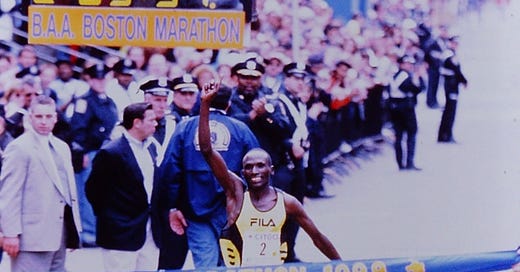Good morning, friends! Happy Saturday.
I’m off to the races today, but I know many of you are gearing up for your last long run before Boston. If you're in town this weekend, you already know — it's cold and rainy out there.
If race day were today, Tailwind is projecting marathon times to be ~5 minutes slower. Remember, you can simulate any condition in our weather app!
For a 4-hour marathoner, that’s about 12 seconds per mile. Nothing unmanageable, but definitely something to factor into your pacing.
We built Tailwind so you can be prepared for anything. I always say: remember how your long runs feel — especially the tough ones — in case you get that same weather on race day. It’s all about managing expectations and having a great plan.
If you’ve got a friend training for Boston, send this briefing their way.
I’ll be back with more musings tomorrow. But for now, let’s take a look at some brighter outlooks…
Tailwind Tracker
Will there be a tailwind? You bet! It’s holding steady.
Temperature at Start: 45°F (7°C)
Temperature at Finish: 49°F (9°C)
Wind: W at 8 mph (13 km/h) — tailwind all the way
Precipitation Chance: 0%
Conditions: Partly Cloudy
Humidity: 53%
Race Day Impact:
Similar years at Boston have yielded times that are on average 1-2 minutes faster than the average.
Let’s Talk Hills
Yes, I know this is a weather newsletter — but we’ve got to talk about the Boston hills. More specifically: the downhills. You’re getting near-perfect conditions this year, with the wind at your back and the crowds bringing the energy. And that’s exactly when people make mistakes.
I’ve seen so many runners ride the early hype and go out too fast. But here’s the thing: those downhills are sneaky. Just 1–3 seconds per mile too quick over the first 10 miles can be enough to turn your legs to mush by the time you hit the Newton Hills.
The best runners know how to work with the course. They stay relaxed early, stay within themselves, and save their strength for the miles that matter. I’m paraphrasing, but Bill Rodgers — multiple-time Boston champ — used to talk about “finessing” Boston. It’s a feel thing. Get it right, and you’ll fly.
If you enjoyed this daily briefing, please pass it along to another runner!
1999: Great Spectator Weather
In 1999, it was one of those days that started out near perfect (temps in the mid-50s) and tricked runners into going out too hard as temps creeped into the 70s through the day. Many runners had to drop out or ran significantly slower than their goals. One runner wrote a detailed report of his day. He was trying to break 3:16 and ran 3:27.
“The lessons I learnt from this race were to put on sun protection when it might be warm (sunburn even if minor creates additional stress for your body), not to trust the weather forecast (I didn't bring my singlet to the start of the race, because of the predicted temperature between 54 and 58), and to drink more water at water stops (at least a full cup every other mile, if it is warm; I drank a lot of water in the 24 hours prior to the race).”
Aforementioned multi-time Boston champ, Bill Rodgers was also trying to break the course record for runners over 50. He was on pace through the halfway mark before dropping out.
''I was whipped,'' Rodgers said. ''I was getting lightheaded and I began to see flashing lights and I knew it was the first signs of dehydration. If I kept going, I would've collapsed. I would've keeled over.''
It’s a good reminder that the forecast doesn’t need to present as “out of control” for even the best runners to be seriously impacted at Boston!





